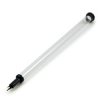durbo
Well-Known Member
- Joined
- Mar 27, 2013
- Messages
- 60
- Reaction score
- 1
I use a plastic fermenter or a 6 gal bucket to ferment in with spigots. So to take my hydrometer readings I generally just use the spigot to fill up my hydrometer then discard the beer that I've taken out, as this seems the easiest way. My problem is...I'm wasting precious beer by doing this. Because of this I take as few readings as I can but I'm just wondering, is there a better way that I've missed? Cheers


